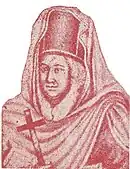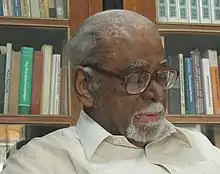| Part of a series on |
| Dravidian culture and history |
|---|
 |
| Portal:Dravidian civilizations |
Dravidian studies (also Dravidology, Dravidiology) is the academic field devoted to the Dravidian languages, literature, and culture. It is a superset of Tamil studies and a subset of Indology.
Early missionaries
The 16th to 18th century missionaries who wrote Tamil grammars or lexica include Henrique Henriques, Bartholomaeus Ziegenbalg and Constantino Giuseppe Beschi.
| Dravidologist | Photo | Period | Work |
|---|---|---|---|
| Henrique Henriques | 1520–1600 | Portuguese Jesuit priest and missionary. After his initial days in Goa he moved to Tuticorin. As a missionary he strongly believed that books of religious doctrines should be in local languages. He is considered to be the first European Tamil scholar. He set up the first Tamil press and got books printed in Tamil script. The first book printed in Tamil script was "Thambiran Vanakkam" (தம்பிரான் வணக்கம்) (1578), a 16-page translation of the Portuguese "Doctrina Christam". Thereby, Tamil became the first non-European language to be printed on a printing press. | |
| Constantine Beschi also called Vīramāmunivar (Tamil: வீரமாமுனிவர்) |  | 1680 –1742 | Italian Jesuit priest and renowned poet in Tamil language. Authored several Tamil dictionaries: including the "Chaturakarati" (சதுரகராதி), a Tamil-Latin and Latin-Tamil-Portuguese dictionary. He translated the famous Thirukkural epic poem of Thiruvalluvar (1730) in Latin. His greatest poetical work is the "Thembavani" (தேம்பாவணி) (the Unfading Garland), a poem on the life of Saint Joseph. |
| Bartholomaeus Ziegenbalg |  | 1682–1719 | Lutheran clergy member and the first Pietist missionary to India. He was among the first Protestant missionaries to arrive in India at the Danish colony of Tranquebar in 1706. He translated the Old and the New Testament into Tamil. In 1708 he compiled "Bibliothece Malabarke", listing the 161 Tamil books he had read and described their content. |
Dravidian language hypothesis
The recognition that the Dravidian languages were a phylogenetic unit separate from Indo-European dates to 1816, and was presented by F. W. Ellis, Collector of Madras, at the College of Fort St. George.
Nineteenth-century experts
The 19th century contributors to the field of Dravidology were:
| Dravidologist | Photo | Period | Work |
|---|---|---|---|
| Francis Whyte Ellis | 1777-1819 | Civil servant. First to propose a Dravidian family of languages | |
| Charles Phillip Brown | 1798–1884 | Collected 2,106 hand written books in South Indian Languages (now with Chennai Library). He provided three services for the Telugu language: he produced his own works in Telugu; he recovered and discovered old Telugu works; and he printed books in Telugu. He authored numerous translations of Telugu works into English. | |
| Robert Caldwell |  | 1814-1891 | Research into the languages and the history of the Dravidian region. |
| Hermann Gundert | .jpg.webp) | 1814 – 1893 | Authored Malayalam grammar book, "Malayalabhaasha Vyakaranam" (1859) and a Malayalam-English dictionary (1872). Published thirteen Malayalam books including Bible translations. |
| Ferdinand Kittel | .jpg.webp) | 1832–1903 | Kannada language and the first Kannada-English dictionary of about 70,000 words in 1894. |
| Benjamin Lewis Rice | 1837-1927 | Renowned for his work Epigraphia Carnatica which contains his study of about 9000 inscriptions found in the Old Mysore area. He published twelve volumes over ten years between 1894 and 1905. He authored "The History of Mysore and Coorg" from inscriptions included in the Epigraphia Carnatica. | |
| U. V. Swaminatha Iyer | 1855–1942 | 91 books related to classical Tamil literature. Collected 3,067 paper and palm-leaf manuscripts. | |
| T. R. Sesha Iyengar | 1887-1939 | Dravidologist renowned for his book "Dravidian India". | |
| K. A. Nilakanta Sastri |  | 1892–1975 | Renowned Dravidologist and prolific historian. Authored 25 historical works mostly on the history of South India. |
| P. T. Srinivasa Iyengar | 1863–1931 | Noted Dravidologist of the 20th century. Authored numerous works on Tamil and Indian history. | |
| Sakkottai Krishnaswami Aiyangar | 1871–1946 | Noted for his work in turning around and running the "Journal of Indian History" in the 1920s. He authored many historical works on South Indian and Indian history. | |
| Korada Ramakrishnaiah | 1891–1962 | Authored 26 works of fundamental importance and extended the borders of Research in Telugu. | |
| V. R. Ramachandra Dikshitar | 1896–1953 | Known for authoring numerous works on Tamil and Indian history. | |
Twentieth-century experts
The noted Dravidologists from the twentieth century are:
| Dravidologist | Photo | Period | Work |
|---|---|---|---|
| Murray Barnson Emeneau | 1904-2005 | Renowned for his work the "Dravidian Etymological Dictionary" (1961), written with Thomas Burrow. Emeneau studies lesser known languages of the Dravidian family - Toda, Badaga, Kolami and Kota. Emeneau is also credited with the study of areal phenomena in linguistics, with his seminal article, "India as a Linguistic Area". | |
| T. Burrow | 1909-1986 | Renowned for his work the "Dravidian Etymological Dictionary" (1961), written with Murray Barnson Emeneau. Also known for his work in Sanskrit. | |
| Kamil Zvelebil |  | 1927–2009 | Czech scholar in Indian literature and Dravidian linguistics. Author of numerous books on Dravidian linguistics and Tamil literature. |
| Bhadriraju Krishnamurti |  | 1928–2012 | Eminent Dravidianist and one of the most respected Indian linguists of his generation. His work "The Dravidian Languages" is considered a landmark volume in the study of Dravidian linguistics. His work "Telugu Verbal Bases" (1961) is the first comprehensive account of comparative Dravidian phonology. He is also author of numerous works in Telugu and English on the subject. |
| Iravatham Mahadevan | 1930–2018 | Renowned for his work on the decipherment of the Tamil-Brahmi script. He also published a corpus of the Indus script and stood by the Dravidian hypothesis. | |
Contemporary programs
The Dravidian University at Kuppam, Andhra Pradesh has created Chairs in the names of Western and Dravidian scholars to encourage research in individual Dravidian languages as well as comparative Dravidian studies:[1]
- Bishop Caldwell's Chair for Dravidian Studies
- C. P. Brown's Chair for Telugu Studies
- Kittel Chair for Kannada Studies
- Constantine Beschi Chair for Tamil Studies
- Gundert Chair for Malayalam Studies.
Literature
- Robert Caldwell, Comparative Grammar of Dravidian Languages (1856; revised edition 1875).
- Bhadriraju Krishnamurti (2003). The Dravidian Languages. Cambridge University Press. ISBN 0521771110.
- Thomas R. Trautmann, Languages and nations: the Dravidian proof in colonial Madras, University of California Press, 2006, ISBN University of California Press, 2006.
- Murray Barnson Emeneau (1994). Dravidian Studies: Selected Papers. Motilal Banarsidass. ISBN 8120808584.
Film
The 2021 Indian documentary film Dreaming of Words traces the life and work of Njattyela Sreedharan, a fourth standard drop-out, who compiled a multilingual dictionary connecting four major Dravidian languages Malayalam, Kannada, Telugu, and Tamil.[2][3][4] Travelling across four states and doing extensive research, he spent twenty five years[5] making this multilingual dictionary.
See also
References
- ↑ Dravidian University fellowships, The Hindu, Saturday, Aug 26, 2006
- ↑ "82-year-old Kerala man's Dictionary is in the four Dravidian languages. 25 long years to compile".
- ↑ "83-YO Kerala School Dropout Creates Unique Dictionary in 4 South Indian Languages". 31 December 2020.
- ↑ Sajit, C. p. (30 October 2020). "For Keralites, door opens to three other Dravidian languages". The Hindu.
- ↑ "The Man Who Wrote A Dictionary In Four Languages - Silver Talkies". silvertalkies.com.
External links
- Dravidian studies in the Netherlands, IIAS newsletter (2005)
- Extracts from T.R.Sesha Iyengar's "Dravidian India" by Dr. Samar Abbas, Bhubaneshwar, 4/8/2003
- Literary Contributions of select list of Tamil Scholars from Overseas
- Roja Muthiah Research Library